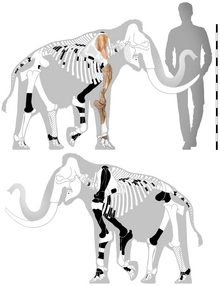Mammuthus lamarmorai
| Sardinian mammoth Temporal range: Pleistocene
| |
|---|---|

| |
| Composite skeleton of known remains showing size of an adult compared to a human. Full scale bar 150 cm, with each black and white section being 10 cm | |
| Scientific classification | |
| Domain: | Eukaryota |
| Kingdom: | Animalia |
| Phylum: | Chordata |
| Class: | Mammalia |
| Order: | Proboscidea |
| Family: | Elephantidae |
| Genus: | †Mammuthus |
| Species: | †M. lamarmorai
|
| Binomial name | |
| †Mammuthus lamarmorai | |
| Synonyms | |
| |
Mammuthus lamarmorai is a species of dwarf
Description

M. lamaromorai is only known from a small number of remains, including a fragmentary partial skeleton, and isolated finds of other bones.[1] Of the few known molars only one represents the rearmost tooth, which is 13 cm long and 6.9 cm wide, with at least eleven ridges on the enamel.[2] The humerus reaches a length of 45 centimetres (18 in).[3] The few discovered tusk fragments exhibit only a small maximum diameter of 3.5 centimetres (1.4 in). The length of the femur indicates a shoulder height of 1.4 metres (4.6 ft).[3] Weight estimates have varied considerably, from 420 kilograms (930 lb) to 1,650 kilograms (3,640 lb).[4] The small size of M. lamarmorai is due to a process of insular dwarfism, which occurred when its original large ancestors reached Sardinia and due to lower food supply and lack of potential predators they reduced their size.[5][6]
Discovery

The holotype specimen of M. lamarmorai is a partial skeleton collected during the late 19th century from Guardia Pisano Hill near Gonnesa in southwest Sardinia, which was being excavated as a result of railway construction.[1]
Most finds of M. lamarmorai were discovered on the west coast and in the western part of the island of Sardinia, and mainly comprise individual finds, but also belong to associated skeletal elements. The most important fossils are from Funtana Morimenta, a quarry south-southwest of
Classification
As a mammoth, M. lamarmorai's closest living relative is the modern Asian elephant (Elephas maximus). The occurrence of this mammoth already in the late Middle Pleistocene makes that a descent from the classic woolly mammoth (M. primigenius) rather unlikely, since this latter species first appeared in Europe during the Upper Pleistocene. Rather, it is thought that the steppe mammoth (M. trogontherii), which lived on the continent, is the likely ancestor of M. lamarmorai. The steppe mammoth's molars had only eleven ridges, a feature much more archaic than those of the woolly mammoth, which had twenty six ridges. The Cretan pygmy mammoth (M. creticus) and M. lamarmorai are the only known dwarf mammoths on the islands of the Mediterranean Sea, which were otherwise occupied by diminutive members of the genus Palaeoloxodon (also included sometimes in Elephas).[5][6]
The remains from Guardia Pisano Hill were initially attributed by Luigi Acconci in 1881 to
Chronology
The origin of M. lamarmorai is still relatively unclear – the earliest finds date from the latter part of the Middle Pleistocene, and it is thought that they colonised the island sometime after 450,000 years ago. This colonisation likely occurred during a glacial period in which the global sea level was much lower due to the continental ice sheets and the animals could reach the island by swimming.
Paleoenvironment
During the Middle-Late Pleistocene Corsica and Sardinia had their own highly
References
- ^ ISSN 2571-550X.
- ISBN 978-3-939414-48-3
- ^ .
- ^ .
- ^ a b Maria Rita Palombo: Endemic elephants of the Mediterranean Islands: knowledge, problems and perspectives. In: G. Cavarretta, P. Gioia, M. Mussi and Maria Rita Palombo (eds.): The World of Elephants – International Congress. Consiglio Nazionale delle Ricerche. Rome, 2001, pp. 486–491
- ^ a b c d Lucia Caloi, Tassos Kotsakis, Maria R. Palombo und Carmelo Petronio: The Pleistocene dwarf elephants from Mediterranean islands. In: Jeheskel Shoshani and Pascal Tassy (eds.): The Proboscidea. Evolution and palaeoecology of the Elephants and their relatives. Oxford, New York, Tokyo, 1996, pp. 234–239
- ^ a b Maria Rita Palombo, M. P. Ferretti, G. L. Pillola and L. Chiappini: A reappraisal of the dwarfed mammoth Mammuthus lamarmorai (Major, 1883) from Gonnesa (south-western Sardinia, Italy). Quaternary International 255, 2012, pp. 158–170
- ^ R. Melis, Maria Rita Palombo und M. Mussi: Mammuthus lamarmorae (Major, 1883) remains in the pre-Tyrrhenian deposits of San Giovanni in Sinis (Western Sardinia, Italy). In: G. Cavarretta, P. Gioia, M. Mussi and Maria Rita Palombo (eds.): The World of Elephants – International Congress. Consiglio Nazionale delle Ricerche. Rom, 2001, pp. 481–485
- .
- S2CID 244763779.
